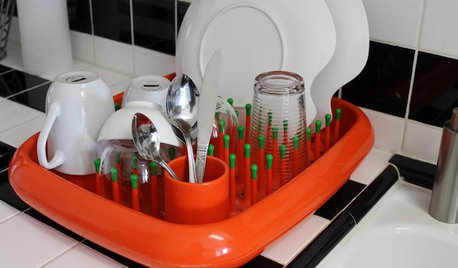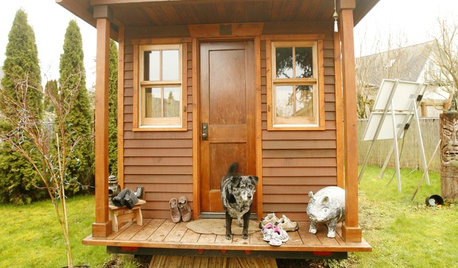Conversations with checkers at grocery stores
Lars
3 years ago
Featured Answer
Sort by:Oldest
Comments (149)
Related Discussions
Hand held scanner at the grocery store!
Comments (21)My ex works in RFID. The question is at what point is it cost-effective to tag every product (including every green pepper - not to mention what about items sold by weight not per item)? Prices are always changing, volume discounts, etc. so I can see it being cost effective for someone like SC Johnson or Kelloggs to tag each product (maybe they're getting tags for 5-10 cents each now) but produce (other than asparagus LOL) and sticks of gum, smaller manufacturers, etc. may not be worth it so won't be tracked. The scanner scans the barcode, which is printed on the package, not the same thing as a unique passive RFID tag with antenna. So Best Buy is probably tagging absolutely everything but Stop and Shop probably not. Oh, and I hate the "please bag your item" voice too - as I'm trying to fit one or two of my bags in the tiny bagging area in self-checkout at Price Chopper, and it doesn't like my insulated bag (too heavy) or yells at me when I remove a bag once it's full. Wish they all had the "Skip bagging" option that HD and Walmart have. But then again I do most of my shopping (other than bulk paper goods) at small local store where they bag for me (using my bags if I want), no self-checkout. BTW, did anyone read in the WSJ where in DC they're taxing paper and plastic bags in food stores? Is that a pain? Here most stores offer 5 cents off if you bring your own bag (but half the time I forget them, and 1/4 of the time I want paper bags so I can recycle my newspapers in them)....See Moregrrrr...wasted my time at the grocery store.
Comments (27)Like a few here, I'd much rather grocery shop than shop for clothes!!! I'm not a one-stop shopper though. My main shopping is done at the Commissary at MCAS Miramar, once a month. That's what we call "Stock up". Then we shop Wal-Mart's food section (limited; we don't have a Super Wal-Mart yet, and though they're planning one, the town criers are lobbying against it). I shop sales and fresh stuff at Stater Bros and Henry's (like a Wild Oats), but will only go into Vons if they have a really good sale on something I need/want (like the red seedless grapes they have today). Wal-Mart, Stater Bros, Henry's and Vons are all within a half mile of my house so gas is not at issue. If Albertsons has something good, there's one on my way home from work, but normally that's not a stop. To Claudia near Bakersfield: I hear ya. My DH and I used to live in a small town in Arizona with one grocery store. Decent grocery prices were 70 miles away, down in Tucson or in Phoenix. We used to make a once-a-week run to Tucson for a class I had to take, so we'd take a cooler along and stop at the grocery store before class. Also, my daughter broke a bottle of Worcestershire in one of our cars about 6 years ago. Whew! It smelled until the day she wrecked that car! DonnaR/CA...See Moreabout grocery store baggers
Comments (31)Exactly. I have watched cashiers reach down the belt to grab something in a box - or worse, dish washing detergent - to put with my cold stuff, which I put on the belt first. I have tried the opposite approach - so they reach for a cold item to put with something packaged. Drives me nuts. And I have so many bags - cooler bags, regular bags - and ice packs in the car to put with the cold stuff - that I no longer have room in my trunk. Most of the cashiers where I shop know that I intend to pack my own groceries - or will ask them to keep the cold stuff, produce etc. together. I am hardly unique - people behind me in the line behind me get very frustrated as they are doing the same as I am - and some people just move to a different cashier. And if anyone has ever had a bottle of dish soap open when placed with food you will understand the horror of it all. Just the other day I asked a young cashier about to bag my dishwashing soap with produce to go home and tell her mother she was going to put regular dishwashing liquid in the dishwasher and clothes washer and wait for her mom's reaction. I always tie a plastic bag around things with tops such as are on dishwashing liquid....See MoreDo your grocery stores have gas rewards?
Comments (25)Here in SW. Pa., we have Shop n Save and Giant Eagle that have the rewards along with double coupons....Giant Eagle is very expensive and I have a feeling they jack up their prices to cover the rewards but they're parking lot is always full... Different times of the year, they will also give double points for gift cards and it's really a savings...I usually make a killing at Christmas time and get all my gift cards at Shop n Save...And then along with the gift card, I usually give my son the rewards (which amounts to free gas) as another gift...With his truck, 30 gallons of gas is a pretty good gift.......See Moresjerin
3 years agoLars
3 years agoElmer J Fudd
3 years agomaifleur03
3 years agoSherry8aNorthAL
3 years agoElmer J Fudd
3 years agoLars
3 years agoUser
3 years agolast modified: 3 years agosephia_wa
3 years agolast modified: 3 years agoJilly
3 years agoSherry8aNorthAL
3 years agoSherry8aNorthAL
3 years agoJilly
3 years agoLars
3 years agolast modified: 3 years ago
Related Stories

CONTEMPORARY HOMESHouzz Tour: A Stunning Church Conversion in Chicago
A former Methodist church built in 1901 finds new life as an awe-inspiring family home
Full Story
ARTThe Best Ways to Care for, Clean and Store Art
Keep your treasures on canvas and paper in top shape with this expert advice from two gallery directors
Full Story
LIFEThe Polite House: How to Set Rules for Adult Children Living at Home
Here are 3 important conversations to have, and the language that will help you succeed
Full Story
LIFE13 Ways to Keep the Peace With Roommates
A few ground rules will help you sidestep conflicts over dirty dishes, laundry, decorating, groceries and more
Full Story
FURNITURE10 Furniture All-Stars of Versatility
With these flexible home furnishings on your team, you'll win points for adaptability in your layout and style wherever they land
Full Story
FALL AND THANKSGIVING6 Easy Fall Centerpieces
With Halloween over and Thanksgiving around the corner, it’s time to add some autumnal style to your table
Full Story
HOUZZ CALLHow Are You Passing the Time at Home Right Now?
Share your thoughts about how you are coping with stress and staying grateful during this difficult time
Full Story
SMALL SPACESLife Lessons From 10 Years of Living in 84 Square Feet
Dee Williams was looking for a richer life. She found it by moving into a very tiny house
Full Story
MOVINGMaking a Home Away From Home
Feeling like a stranger in a strange land? These tips can help ease the transition after a big move
Full StorySponsored
Columbus Area's Luxury Design Build Firm | 17x Best of Houzz Winner!







Islay Corbel